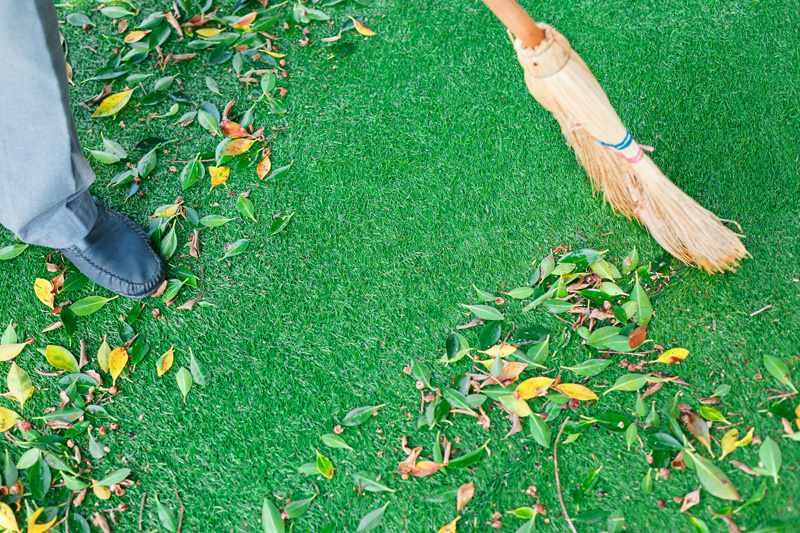Posted: 13th October 2023 | Author: Jamie Brown
Back to news
One reason that artificial grass has become so popular over recent years is that it requires far less maintenance than a traditional lawn. Since the grass isn’t real, the turf will stay lush and verdant all year round, making it an excellent choice for those who lack green fingers.
However, that’s not to say that there is no maintenance associated with artificial lawns. A few simple habits and routines can help to keep your artificial grass clean and tidy so that it always looks its best.
Maintaining the look of your artificial grass is simple compared to natural grass, and it doesn’t take much effort. Whether you’re thinking of laying artificial turf in your garden or you have some already, keep reading to learn more about maintaining an artificial lawn.
When we talk about large debris, we mean anything from fallen branches and pine cones to dropped rubbish or dry food from your last picnic. Pick these things up sooner rather than later and dispose of them in whichever way is best for the item in question. You might find that the frequency with which you need to do this differs depending on the season. However, it may be easiest to get into the habit of walking around your turf every day or two so that you can spot any debris lying around - as well as catching a breath of fresh air.
In this case, smaller debris refers to the things it would be painstaking to get rid of by hand - such as fallen leaves or seeds from neighbouring plants. You can pick these up by hand if you wish, but if you’re like us and you don’t have the patience, a leaf blower or a broom can speed the job up.
As with larger debris, the need for this can change with the seasons. Chances are you’ll need to remove the most debris in autumn when the trees lose their leaves, but it’s worth keeping on top of it during the rest of the year too. As well as brushing the grass to remove small debris, we recommend doing this once a week in order to maintain the pile of the grass - in other words, to encourage it to stand up straighter and prevent the lawn from looking flat.
Whether it’s your pets using your lovely new lawn as a lavatory or foods and drinks being spilled during a party, it’s likely you’ll need to clean up a mess at some point. Fortunately, it’s not too difficult to do this, and it won’t ruin your lawn.
If there is a solid component to the waste - food or otherwise - the first step is to remove this using a scoop or similar tool. The quicker you can do this, the better, as it helps to prevent any odours from remaining behind.
Next, or first if it was a wholly liquid stain, use a cleaning rag or paper towel to blot the stain. You want to get as much of the liquid up as possible without scrubbing the stain, as this could push it further into the fabric of your artificial grass.
Once you’re satisfied you’ve removed as much as possible, it’s time to wash the area. Opt for warm water mixed in with a mild detergent - dish soap or baby shampoo can work. Gently clean the area, then rinse with cool water to remove any residue. Avoid walking on the grass until it’s dry again.
Top tip! Never use strong acidic or alkaline cleaning solutions on your grass. This can not only cause discolouration, but may also affect the integrity of the material, preventing your artificial lawn from looking its best.
Whenever you’re using tools to help remove debris, waste or snow from your artificial turf, remember never to use force. Hard metal tools should also be avoided - we recommend sticking to plastic snow shovels and brooms that use natural materials such as Bassine or coir.
One question that comes up a lot when we discuss artificial grass maintenance with those looking to install is whether or not the turf can be cleaned with a vacuum cleaner. Unfortunately, using a vacuum cleaner is likely to be damaging, not just to your artificial turf but also to your vacuum cleaner itself. Any water or dampness that gets into the vacuum cleaner can impact its working efficiency and may even cause an electrical hazard.
On top of that, there is the risk that vacuum cleaners could remove the sand or aggregate laid below your turf, leading to uneven ground, puddling and drainage issues. The weight of a vacuum cleaner may also affect the pile of the grass, potentially making it look flat and unappealing.
While jet washing may seem like a time-saving alternative to rinsing down your turf, it can actually be damaging to the fibres that act as individual blades of grass. These can bend or snap under the pressure of the jet wash, which may leave your lawn looking flat, lacklustre or even bare.
We recommend rinsing your lawn by hand, simply by pouring water from a jug or bucket over the area. Alternatively, you could use a hose - just make sure to keep it at its lowest pressure setting to help protect your artificial turf.
Back to news
The Author: Jamie Brown
From my early working life as a labourer, then becoming a builder and a property developer, I have been buying and using building materials for over 25 years. I set about to start a builders merchant which can offer high-quality products and significant savings along with speedy delivery to keep your sites moving. Still having a foot in the construction industry on my own property, I always make sure the products we sell are up to our high standards which is important for us to keep a great image for the company and superior reputation to supply quality!